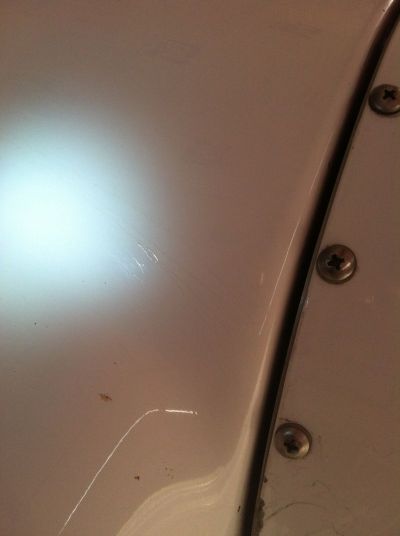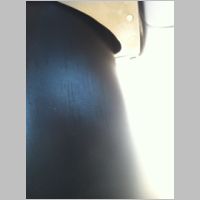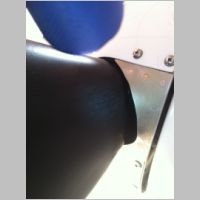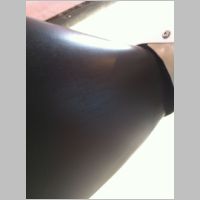Oil Leak Solved
Added 6/9/2012Hopefully the tips in this write-up can save you lots of headaches!
I had a very minor oil leak. You could see oil spots that were so small, they were just pinprick in size on the windshield. They ONLY were on the co-pilot side. Back then, I also had some oil inside my ring gear area, and dripping down hanging from the starter and under my engine a bit.
Everything at the time pointed to being my crankshaft seal. I had replaced one years ago on my Sundowner, so I knew it was a bit like the seal giving birth to a crankshaft flange when you stretched it out. I replaced it, only to find that while I was getting less oil on the engine, the oil was still on my windshield. It *seemed* to be a little less, but was still there. I flew it for a while, after cleaning up some oil a little, to see if it was just residual drops in the cowl and engine that were making their way up, but it kept coming. So over the winter I figured I screwed up the seal job and did it AGAIN. The original seal was indeed cracked all around the lips, and at 800 hours and 6 years was getting older.
Well that didn't fix it either. I may have not done it perfectly the first time around as there was a tiny bit of oil on my
inside of the ring gear, but it was not BAD. I kept poking at it, tracking down everything I could to find the oil leak.
Eventually I resorted to adding UV dye to the oil. If you do this, keep it a SHORT TERM thing and don't do it unless
you plan to stick with the problem until you find it...within a few days. Then change your oil. The reason is, if you
spread all that dye filled oil in your engine and it leaks all over, pretty soon your whole engine will glow. So resort to that when you need to, but keep it short term and once you start diagnosing, don't stop and fly a lot until you find it. For me, the dye helped some though.
I ended up getting to the point I had to degrease the entire engine with Mineral Spirits solvents and then rinse off with water and wipe the whole thing down with paper towels so that I had a totally clean engine to start with. I replaced an oil cooler hose, as part of the troubleshooting, to ensure that the fitting wasn't leaking (I couldn't keep it dry). I replaced my cylinder oil drain rubber tubes, which definitely had hardened and a few were slightly leaking. I removed and cleaned and sealed a couple sump bolts and other things. Once I did all that, and after the 2nd crank seal, I no longer had any oil in my ring gear, and my engine started to stay dry of any new oil leaks.
BUT, I still had oil on my windshield. If you look at the first photo below, you'll see the gap by the spinner and the streaks of the oil flowing back. They'd trail up to the windshield. I could NOT see the oil streaks go INTO the air inlets, although on the copilot side a few originated at the front upper part of the air inlet. This turns out to be a pretty key signal.
Being at a loss of where the engine could be leaking, I called Hartzell to ask where oil could leak from the prop. I had to make SURE there wasn't any oil that could leak out. I had a theory....since the engine was staying totally dry, if there was a prop oil leak it would get flung outward a little ways until the wind hit it. Then, the DOWNWARD blade as it passes the cowl, leaves a small gap between the blade and cowl. If oil were to fling off there, it would get thrown backwards and squeezed into that gap, and hit the cowl...running backwards along the top, initiating at the front edge of the cowl. I also didn't see any oil down the spinner gap, so the oil appeard to be just bleeding out of the cowl itself. This pointed me to the prop...so I had to call Hartzell to verify. My prop appeared dry of all oil though inside around the hub, so I didn't know how it could possiby be the prop. They said there wasn't any oil down the shaft where it enters the hub, only grease, so it was unlikely to be oil.
Click to Enlarge

So one night after cleaning it all good, I, and preparing for a test flight to find if anything leaked, my wife was looking things over with me and she saw something that was very hard to see without the right lighting and reflection. If you notice the photos below, the 3rd one I think was taken before the test flight. You could see streaks of something on the inside back side of the propeller, fanning out about 8 inches. This was the smoking gun that SOMETHING was coming out of my prop hub.
 |
 |
 |
I pulled the spinner off and found NOTHING that was oil leaking anywhere. I was baffled. I did find grease inside my spinner in a couple globs, and on that metal ear behind the blade, so I *DID* see grease being flung about. But, the stuff on the cowl for all practical purposes was OIL, because it was thin and runny. I decided to try a test....
I wiped the back of the blades with degreaser and got it all clean, and took a short flight. The result showed stuff like in photos 1 and 2...some very fine streaks that were fresh. So that was a big gotcha. I took the spinner off AGAIN and wiped ALL of the grease out from the spinner, the prop hub area, and grease zerks where there was a little excess grease. I took paper toweling and wiped deep into the gap at the base of the prop ears...there was a coating of grease all around that cavity. Also, under the plastic caps on the grease zerks the grease in there was very oily...so I cleaned that off too...everything got cleaned. I then went flying again.
THERE WAS NO OIL ANYMORE!
So now I knew, it wasn't oil, it was grease. I called Hartzell the next day to confirm that I wasn't crazy. Indeed, Aeroshell 6 grease does tend to separate, especially in warmer temps. You'll be left with a paste and an oily component. Sure enough, the oil was coming out my seals and flinging back into the cowl, ONLY on the right side of the cowl because the left side is the upswing blade that has more of a slope to the cowl and it doesn't squeeze the air the same and deposit it there.
Further, they asked me how many years the prop has been in service, because they said at 5-6 years you could (if operating commercially) be getting near TBO based on time in service and seals sometimes only last 5-6 years. I had been flying about 800 hours over 6 years. So depending on the flight rules you operate under, you could be nearing the TBO for a rebuild. Being experimental and part 91, we're not subject to that TBO, but our seals still age the same.
There also is one other MAJOR factor... I now remember the last time I greased my prop, in the past I pulled one of the 2 grease fittings on each side, and pumped in grease until it came out the other fitting. Well, this winter when I did it, during one of those crank seal replacements, I pumped in grease and it wasn't coming out. I must have pumped 20 or 30 times. If you read the manual carefully you'll see that they say to "pump 1 oz. of oil or 6 pumps, whichever comes first." (I hope I quoted that right). So clearly I at least have the potential for being the CAUSE of the leak...over servicing the prop with grease. So what started as an oil leak was indeed an oil leak, but the persistent remaining leak was just liquified prop grease.
My prop is now being re-sealed by a prop shop. They have updated the seals since the prop came out, and they will be replacing all of the seals and the teflon backing rings too. Apparently there are teflon rings in there that get a groove worn in and can cause leaks too. All better, and just in time for my next adventure!
Update: I got the prop back and learned a few things while I talked to them. First, they do NOT recommend 100 hour greasings. At most you'd want to do it annually, but then make SURE to stick to the 1oz recommendation and also use safety wire on the opposite zerk to dig out any pasted grease so it comes out easily. In fact, there is a saying that "if it ain't leaking, don't grease it" which makes some sense now that I've seen a cutaway view. Inside there, you don't have lots of fast rolling bearings...just bearings that let you rotate the prop. The grease just lubes that area and keeps it from rusting. So, it's unlikely to wear out the grease very fast, and if it isn't leaking it's probably going to last many many years. They feel that although they wouldn't recommend it, you could run to TBO on the grease that's in there if it doesn't leak out. So, don't overgrease for sure...it's not like wheel bearings that need to be done real often. Also, apparently the original seals from Hartzell were "quad" (square) seals, and those leaked a lot. Hartzell changed their seals later, and those leaked real bad too. The prop shop actually had some better seals made up at one time that were round and made of something else. Not all that long ago, Hartzell finally updated their seal to some nice silicone material that lasts longer and seals better. So if you get new seals it will likely be better than original if you have the older seals of other types.
With all of this done, I got the prop on and did a test flight and my leak problem is definitely gone!
Site Home | N104CD Home